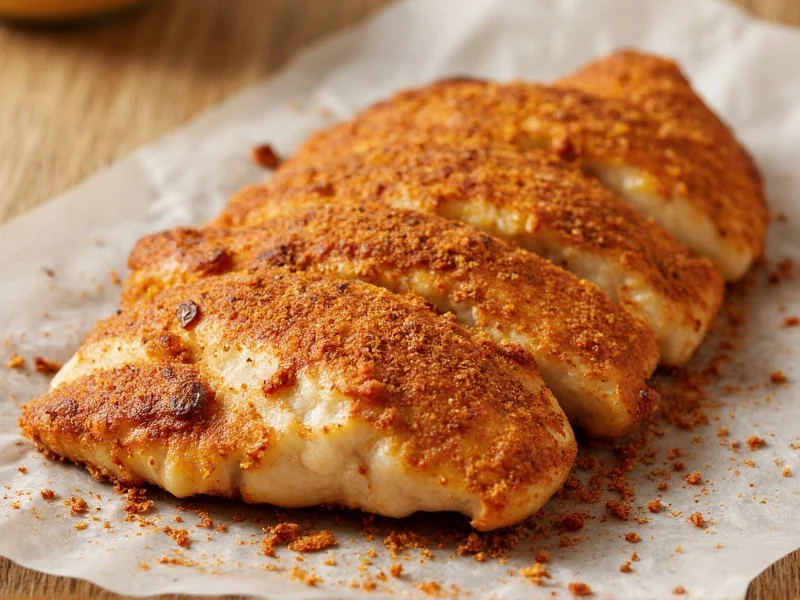Understanding what's in blackened fish seasoning helps home cooks recreate authentic Creole flavors. This distinctive spice blend originated in New Orleans cuisine, specifically developed by Chef Paul Prudhomme in the 1980s. The magic happens when these dry spices hit a screaming hot cast-iron skillet, creating that signature dark crust without burning the fish.
Core Components of Authentic Blackened Fish Seasoning
The specific combination of spices serves multiple purposes in blackened fish preparation. Each ingredient contributes to flavor, color, and the unique textural crust that defines this cooking method. Unlike regular seasoning blends, blackened seasoning must withstand extremely high heat without burning while still delivering complex flavors.
Detailed Ingredient Breakdown
Let's examine each component and its culinary role in proper blackened fish seasoning:
| Ingredient | Typical Percentage | Primary Function |
|---|---|---|
| Paprika (preferably smoked) | 25-30% | Provides rich red color and forms the dark crust when seared; smoked variety adds depth |
| Garlic Powder | 15-20% | Imparts savory umami notes without burning like fresh garlic would |
| Onion Powder | 10-15% | Contributes sweetness and aromatic base notes |
| Cayenne Pepper | 5-10% | Delivers the characteristic heat; amount varies by recipe |
| Black Pepper | 8-12% | Adds pungency and complexity; freshly ground works best |
| Dried Thyme | 5-8% | Contributes earthy, slightly floral notes typical of Creole cuisine |
| Dried Oregano | 5-8% | Provides herbal complexity and Mediterranean influence |
| Salt | 15-20% | Essential for flavor enhancement and moisture control during searing |
How Blackened Seasoning Creates the Signature Crust
The "blackened" effect isn't actually burning—it's a carefully controlled Maillard reaction combined with the caramelization of spice components. When properly applied to fish and cooked in a smoking-hot skillet, the paprika and other spices create a dark, flavorful crust while the interior remains moist. The salt draws out surface moisture, allowing the spices to adhere and sear properly rather than steam.
Many commercial blends include additional ingredients like lemon pepper, celery salt, or even small amounts of sugar to enhance crust formation. However, traditional New Orleans-style blackened seasoning sticks to the core ingredients without sweeteners.
Variations Across Recipes
While the basic formula remains consistent, regional and personal variations exist:
- Spicy versions: Increase cayenne to 15% and add a pinch of red pepper flakes
- Milder versions: Reduce cayenne significantly and increase paprika proportion
- Citrus-enhanced: Add lemon or orange zest (1-2%) for brightness
- Smoky variations: Use chipotle powder instead of some regular paprika
Professional chefs often toast whole spices before grinding them for homemade blackened seasoning, which intensifies flavors but requires more preparation time.
Proper Application Techniques
Knowing what's in blackened fish seasoning is only half the battle—proper application matters equally. For best results:
- Dry the fish thoroughly before seasoning
- Apply a generous, even coat of seasoning (about 1 tablespoon per half-pound of fish)
- Press the seasoning gently into the fish surface
- Use a cast-iron skillet preheated to smoking point
- Cook for 2-3 minutes per side depending on thickness
Avoid common mistakes like using too little seasoning (results in pale fish) or overcrowding the pan (causes steaming instead of searing).
Homemade vs. Commercial Blends
While store-bought blackened seasoning offers convenience, homemade versions typically contain fresher spices without fillers or anti-caking agents. Commercial blends sometimes include ingredients like maltodextrin or silicon dioxide that don't contribute to flavor. Making your own allows customization of heat level and ensures maximum flavor potency, as ground spices lose potency within 6 months.
Storage and Shelf Life Considerations
Whether homemade or store-bought, proper storage affects seasoning quality. Keep blackened fish seasoning in an airtight container away from light and heat. Properly stored, it maintains peak flavor for 3-6 months. The oils in spices can go rancid over time, particularly if the blend contains any ground seeds or additional oils sometimes found in commercial versions.
Frequently Asked Questions
What's the difference between blackened and Cajun seasoning?
Blackened seasoning is specifically formulated for high-heat searing and typically contains higher proportions of paprika and salt to facilitate crust formation. Cajun seasoning tends to be more versatile for general cooking with balanced heat and herbs, often containing additional ingredients like bell pepper powder. Blackened blends usually have less thyme and oregano than traditional Cajun mixes.
Can I use blackened seasoning for foods other than fish?
Absolutely—blackened seasoning works well with chicken, shrimp, scallops, and even vegetables like cauliflower or sweet potatoes. The high-heat cooking method creates excellent flavor on many proteins and hearty vegetables. Just adjust cooking times based on the food being prepared, as fish requires less time than chicken or steak.
Why does my blackened fish always burn?
Burning typically occurs when the skillet isn't hot enough before adding the fish, causing the spices to stick and burn rather than sear properly. The skillet should be smoking hot (around 400-450°F). Another common issue is using too much oil—blackened cooking requires minimal oil as the spices themselves create the crust. Finally, ensure your seasoning doesn't contain sugar, which burns quickly at high temperatures.
Is blackened fish seasoning gluten-free?
Pure blackened fish seasoning containing only spices and salt is naturally gluten-free. However, some commercial blends may contain anti-caking agents or be processed in facilities with gluten-containing products. Always check labels if you have gluten sensitivity, and consider making your own blend to ensure it's completely gluten-free.











 浙公网安备
33010002000092号
浙公网安备
33010002000092号 浙B2-20120091-4
浙B2-20120091-4